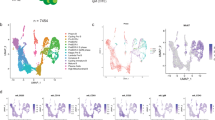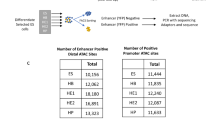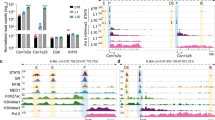Abstract
It is now established that the transcription factors E2A, EBF1 and Foxo1 have critical roles in B cell development. Here we show that E2A and EBF1 bound regulatory elements present in the Foxo1 locus. E2A and EBF1, as well as E2A and Foxo1, in turn, were wired together by a vast spectrum of cis-regulatory sequences. These associations were dynamic during developmental progression. Occupancy by the E2A isoform E47 directly resulted in greater abundance, as well as a pattern of monomethylation of histone H3 at lysine 4 (H3K4) across putative enhancer regions. Finally, we divided the pro-B cell epigenome into clusters of loci with occupancy by E2A, EBF and Foxo1. From this analysis we constructed a global network consisting of transcriptional regulators, signaling and survival factors that we propose orchestrates B cell fate.
This is a preview of subscription content, access via your institution
Access options
Subscribe to this journal
Receive 12 print issues and online access
$209.00 per year
only $17.42 per issue
Buy this article
- Purchase on Springer Link
- Instant access to full article PDF
Prices may be subject to local taxes which are calculated during checkout








Similar content being viewed by others
References
Cosgrove, M.S. Histone proteomics and the epigenetic regulation of nucleosome mobility. Expert Rev. Proteomics 4, 465–478 (2007).
Ruthenburg, A.J., Li, H., Patel, D.J. & Allis, C.D. Multivalent engagement of chromatin modifications by linked binding modules. Nat. Rev. Mol. Cell Biol. 8, 983–994 (2007).
Pokholok, D.K. et al. Genome-wide map of nucleosome acetylation and methylation in yeast. Cell 26, 517–527 (2005).
Heintzman, N.D. et al. Distinct and predictive chromatin signatures of transcriptional promoters and enhancers in the human genome. Nat. Genet. 39, 311–318 (2007).
Kee, B.L. & Murre, C. Induction of EBF and multiple B lineage genes by the helix-loop-helix protein E12. J. Exp. Med. 188, 699–713 (1998).
Ikawa, T., Kawamoto, H., Wright, L.Y. & Murre, C. Long-term cultured E2A-deficient hematopoietic progenitor cells are pluripotent. Immunity 20, 349–360 (2004).
Inlay, M.A. et al. Ly6d marks the earliest stage of B-cell specification and identifies the branchpoint between B-cell and T-cell development. Genes Dev. 23, 2376–2381 (2009).
Beck, K., Peak, M.M., Ota, T., Nemazee, D. & Murre, C. Distinct roles for E12 and E47 in B cell specification and the sequential rearrangement of immunoglobulin light chain loci. J. Exp. Med. 206, 2271–2284 (2009).
Decker, T. et al. Stepwise activation of enhancer and promoter regions of the B cell commitment gene Pax5 in early lymphopoiesis. Immunity 30, 508–520 (2009).
Roessler, S. et al. Distinct promoters mediate the regulation of Ebf1 gene expression by interleukin-7 and Pax5. Mol. Cell. Biol. 2, 579–594 (2007).
O'Riordan, M. & Grosschedl, R. Coordinate regulation of B cell differentiation by the transcription factors E2A and EBF. Immunity 11, 21–31 (1999).
Liu, P. et al. Bcl11a is essential for normal lymphoid development. Nat. Immunol. 4, 525–531 (2003).
Dengler, H.S. et al. Distinct functions for the transcription factor Foxo1 at various stages of B cell differentiation. Nat. Immunol. 9, 1388–1398 (2008).
Amin, R.H. & Schlissel, M.S. Foxo1 directly regulates the transcription of recombination-activating genes during B cell development. Nat. Immunol. 9, 396–404 (2008).
Nutt, S.L., Heavey, B., Rolink, A.G. & Busslinger, M. Commitment to the B-lymphoid lineage depends on the transcription factor Pax5. Nature 401, 556–572 (1999).
Pongubala, J.M. et al. Transcription factor EBF restricts alternative lineage options and promotes B cell fate commitment independently of Pax5. Nat. Immunol. 9, 203–215 (2008).
Murre, C. Developmental trajectories in early hematopoiesis. Genes Dev. 15, 2366–2370 (2009).
Cui, K. et al. Chromatin signatures in multipotent human hematopoietic stem cells indicate the fate of bivalent genes during differentiation. Cell Stem Cell 4, 80–93 (2009).
Visel, A. et al. ChIP-Seq accurately predicts tissue-specific activity of enhancers. Nature 12, 854–858 (2009).
Heintzman, N. et al. Histone modifications at human enhancers reflect global cell-type specific gene expression. Nature 459, 108–112 (2009).
Agata, Y. et al. Regulation of T cell receptor beta gene rearrangements and allelic exclusion by the helix-loop-helix protein, E47. Immunity 27, 871–884 (2007).
Barski, A. et al. High resolution profiling of histone methylations in the human genome. Cell 129, 823–837 (2007).
Ward, J.H. Hierarchical grouping to optimize an objective function. J. Am. Stat. Assoc. 58, 236–242 (1963).
Shannon, P. et al. Cytoscape a software environment for integrated models of biomolecular interaction networks. Genome Res. 13, 2498–2504 (2003).
Maere, S., Heymans, K. & Kuiper, M. Bingo: a Cytoscape plugin to assess overrepresentation of Gene Ontology categories in biological networks. Bioinformatics 21, 3448–3449 (2005).
Medina, K.L. et al. Assembling a gene regulatory network for specification of the B cell fate. Dev. Cell 7, 607–617 (2004).
Ikawa, T., Kawamoto, H., Goldrath, A.W. & Murre, C. E proteins and Notch signaling cooperate T lineage specific progression and commitment. J. Exp. Med. 15, 1329–1342 (2006).
Tothova, Z. et al. FoxOs are critical mediators of hematopoietic stem cell resistance to physiologic oxidative stress. Cell 128, 325–339 (2007).
Yang, Q. et al. E47 controls the developmental integrity and cell cycle quiescence of multipotential hematopoietic progenitors. J. Immunol. 181, 5885–5894 (2008).
Dias, S., Mansson, R., Gurbuxani, S., Sigvardsson, M. & Kee, B.L. E2A proteins promote development of lymphoid-primed multipotent progenitors. Immunity 29, 217–227 (2008).
Semerad, C.L., Mercer, E.M., Inlay, M.A., Weissman, I.L. & Murre, C. E2A proteins maintain the hematopoietic stem cell pool and promote the maturation of myelolymphid and myeloerythorid progenitors. Proc. Natl. Acad. USA 106, 1930–1935 (2009).
Bain, G. et al. Both E12 and E47 allow commitment to the B cell lineage. Immunity 6, 145–154 (1997b).
Llorian, M., Stamataki, Z., Hill, S., Turner, M. & Martensson, I.L. The PI3K p110δ is required for down-regulation of RAG expression in immature B cells. J. Immunol. 178, 1981–1985 (2007).
Quong, M.W. et al. Receptor editing and marginal zone B cell development are regulated by the helix-loop-helix protein, E2A. J. Exp. Med. 199, 1101–1112 (2004).
Anzelon, A.N., Wu, H. & Rickert, R.C. Pten inactivation alters peripheral B lymphocyte fate and reconstitutes CD19 function. Nat. Immunol. 4, 287–294 (2003).
Sayegh, C.E., Quong, M.W., Agata, Y. & Murre, C. E-proteins directly regulate expression of activation-induced deaminase in mature B cells. Nat. Immunol. 4, 586–593 (2003).
Suzuki, A. et al. Critical roles of Pten in B cell homeostasis and immunoglobulin class switch recombination. J. Exp. Med. 197, 657–667 (2003).
Engel, I. & Murre, C. E2A proteins enforce a proliferation checkpoint in developing thymocytes. EMBO J. 23, 202–211 (2004).
Hagenbeek, T.J. et al. The loss of PTEN allows TCR αβ lineage thymocytes to bypass IL-7 and Pre-TCR-mediated signaling. J. Exp. Med. 200, 883–894 (2004).
Engel, I. & Murre, C. Disruption of pre-TCR expression accelerates lymphomagenesis in E2A-deficient mice. Proc. Natl. Acad. Sci. USA 99, 11322–11327 (2002).
Paik, J.H. et al. FoxOs are lineage-restricted redundant tumor suppressors and regulate endothelial cell homeostasis. Cell 28, 309–323 (2007).
Bain, G. et al. E2A deficiency leads to abnormalities in α/β T-cell development and to rapid development of T-cell lymphomas. Mol. Cell. Biol. 17, 4782–4791 (1997a).
Reya, T.O., Riordan, M., Okamura, R., Devaney, E., Willert, K., Nusse, R. & Grosschedl, R. Wnt signaling regulates B lymphocyte proliferation through a LEF-1 dependent mechanism. Immunity 13, 15–24 (2000).
Acknowledgements
We thank G. Hardiman, C. Ludka, L. Edsall and Z. Ye for help with Solexa DNA sequencing; R. DePinho (Harvard Medical School) for Foxo1-deficient mice; J. Sprague and R. Sasik for microarray analysis; and members of the Murre laboratory for comments on the manuscript. Supported by the National Institutes of Health (1F32CA130276 to Y.C.L., P01DK074868 to C.B., F32HL083752 to S.H., CA52599 to C.K.G., AI05466 to J.H. and CA054198-20 to C.M.) and the National Science Foundation (IIS-0803937 to T.I. and BIOGEM DK063491 to the University of California, San Diego Core Facility).
Author information
Authors and Affiliations
Contributions
Y.C.L. designed and did experiments, analyzed data and wrote the manuscript; S.J. and C.B. wrote programs and analyzed data; S.H. did CTCF ChIP-Seq and monomethylation of H3K4 in RAG-deficient pro-B cells; J.H. generated EBF-deficient pre-pro-B cells; M.S. provided anti-EBF; E.W. and R.M. analyzed E2A-Foxo1–deficient mice; C.A.E. did ChIP-Seq experiments during the initial phase of the study; J.D. and T.I. applied computational approaches to generate a global network; C.K.G. analyzed data and edited the manuscript; and C.M. designed experiments, analyzed data and wrote the manuscript.
Corresponding authors
Ethics declarations
Competing interests
The authors declare no competing financial interests.
Supplementary information
Supplementary Text and Figures
Supplementary Figures 1–9 and Supplementary Tables 1–7 (PDF 3651 kb)
Rights and permissions
About this article
Cite this article
Lin, Y., Jhunjhunwala, S., Benner, C. et al. A global network of transcription factors, involving E2A, EBF1 and Foxo1, that orchestrates B cell fate. Nat Immunol 11, 635–643 (2010). https://doi.org/10.1038/ni.1891
Received:
Accepted:
Published:
Issue Date:
DOI: https://doi.org/10.1038/ni.1891
This article is cited by
-
A pro B cell population forms the apex of the leukemic hierarchy in Hoxa9/Meis1-dependent AML
Leukemia (2023)
-
The advances of E2A-PBX1 fusion in B-cell acute lymphoblastic Leukaemia
Annals of Hematology (2023)
-
Pioneer factors as master regulators of the epigenome and cell fate
Nature Reviews Molecular Cell Biology (2022)
-
Age-Progressive and Gender-Dependent Bone Phenotype in Mice Lacking Both Ebf1 and Ebf2 in Prrx1-Expressing Mesenchymal Cells
Calcified Tissue International (2022)
-
B1a and B2 cells are characterized by distinct CpG modification states at DNMT3A-maintained enhancers
Nature Communications (2021)



